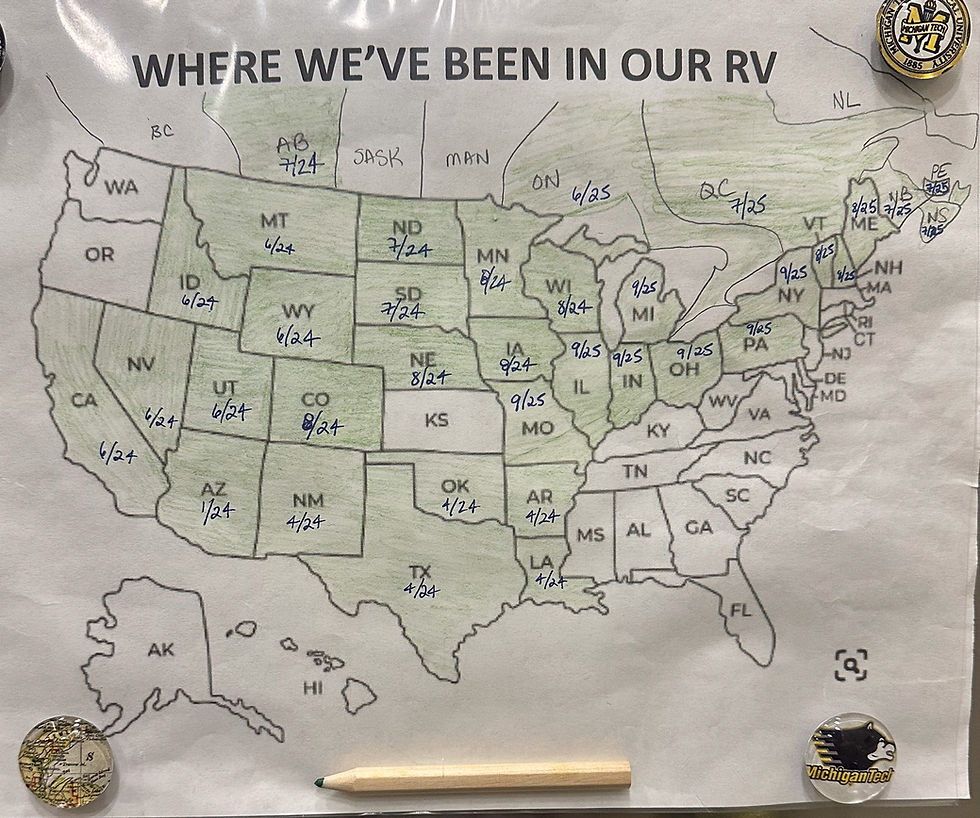Prince Edward Island
- cherylmccutcheon19
- Jul 18
- 4 min read
7/14/25 - On the way to Prince Edward Island (PEI) (another province/state in Canada), we stopped for a lobster lunch in Shediac, New Brunswick, the "lobster capital of the world".



7/15/25 - We drove along the Central and North Cape Coastal Drives to explore the western half of the island.







On the way back to our truck, we saw a camper van with Swiss license plates. The owners walked up as we were looking and they told us it was cheaper to ship their vehicle across the Atlantic ($1500) than to rent one for 3 months ($5000)!
We took the highways back and based on TripAdvisor reviews, the restaurant closest to our campground had the best lobster. When we pulled up to "New Glasgow Lobster Suppers" there was a tour bus and about 100 cars! We figured we wouldn't want to wait but decided to get some details. There was a minimal wait due to the number of tables and size of the staff. Plus the "set" menu: you decide at check-in what size lobster you want and the rest of your meal is the same...all you can eat fresh rolls, seafood chowder, steamed mussels, potato salad, coleslaw, lobster, and dessert! Luckily we opted for the smallest lobster: 1 pound. All of this for US$45. Last time we ordered lobster in the US, it was at least $50 for much less food.


We had concluded after this first day that we love PEI! It reminded us of Ireland with its rolling, green hills filled with crops up to the ocean, friendly, English-speaking people (with Canadian accent, of course), and great food!
7/16/25 - We had a quiet morning / afternoon. At 4:30 we left for our "Lobster Fishing Tour".







Before returning to harbor, they served us an excellent lobster roll meal.
7/17/25 - We drove about 30 minutes into Charlottetown (the capital and biggest city on PEI) to buy a bike tailgate pad...we had decided this would be easier than Pat having to move the bike rack between the RV and the truck when we want to drive somewhere with the bikes. We used it as soon as we got back to the RV to take the bikes to PEI National Park, where we rode after lunch.


In the evening we went to a show in the town of Summerside.


Since we were thinking PEI was "Irish", on the way home I googled Scottish and Irish immigration to the Maritimes:
The Irish and Scottish communities both played significant roles in shaping the culture and history of the Canadian Maritimes. While there are similarities, due to shared Celtic roots, there are also key differences in how each group settled and influenced the region.
Scottish arrived late 1700s/early 1800s due to Highland Clearances (when Scottish landowners evicted tenants to make way for sheep farming). They often settled in rural areas and established tight-knit farming and fishing communities. Cape Breton Island, NS, became a stronghold of Gaelic-speaking Scots. Nova Scotia literally means "New Scotland" and has a strong tradition of fiddle music, ceilidhs (a traditional Gaelic social gathering), and Highland games.
Irish arrived mid-1800s during the Great Famine. They tended to settle in both rural and urban areas. Settled primarily in PEI, Saint John, NB, and Halifax, NS.
Scottish vs Irish ethnic origins now:
PEI: 38% Scottish, 28% Irish.
Nova Scotia: 30% Scottish, 22% Irish.
New Brunswick: 18% Scottish, 20% Irish.
Newfoundland/Labrador: 7% Scottish, 21% Irish.
7/18/25 - The day was supposed to have some rain so we stuck around the RV to relax and do some chores. We still have several days on PEI left!! 😊



Comments